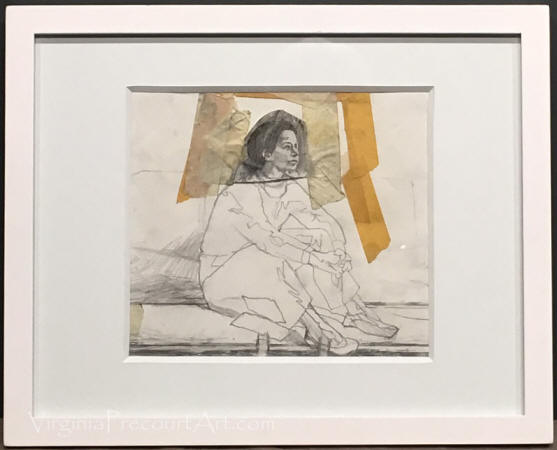
About Virginia
~~~~~~~~~~~~~~~~~~~~~~~~~~~~~~~~~~~~~~~~~~~~

Self-portrait. Pencil on paper
“I’ve been asked so many times why in the world I went
to Afghanistan so many times,” Virginia Strom Precourt told an evening audience
at Boston’s Algonquin Club.
Her answer? “It has rocks. And I love rocks.
“Afghanistan has great, huge, beautiful rocks that are
full of minerals and has sparked civilization for hundreds of years.
“I wanted to go to Afghanistan because I work with
rocks.”
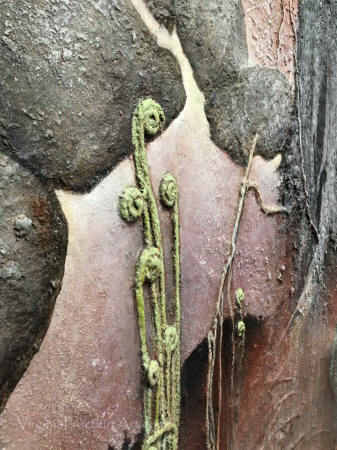
Detail: Early Risers, Rocky Brook (2004)
The country in her 2004 address largely no longer
exists. But Virginia traveled the world to find the right materials that would
advance her mission of creating work that had not just artistic integrity but
also would survive for generations.
Afghanistan had rocks that were integral to Virginia’s
work. “I grind them up and combine them with other materials to create what I
call ‘polyfrescos’,” she continued. And the stones of Afghanistan, Bhutan, Iran,
and Nepal that were integrated into her art gave her panels an extra dimension:
“Those semi-precious stones sparkled like fireflies when the light hit them.”
Indeed, the passion for just the right color in just the
right painting brought her to a small village outside Kabul: She was in search
of a special blue—"turquoise and maybe just a touch of cobalt”— that she had
seen in a book, a museum, or another piece of art. She wasn’t certain of its
source, but the vision of blue was sharp in her mind’s eye.
As she traveled toward the Khyber Pass, she recalled,
“The rocks looked like they were going to crash down on us.”
The upside: “There was a variety of colors and textures
of those rocks.
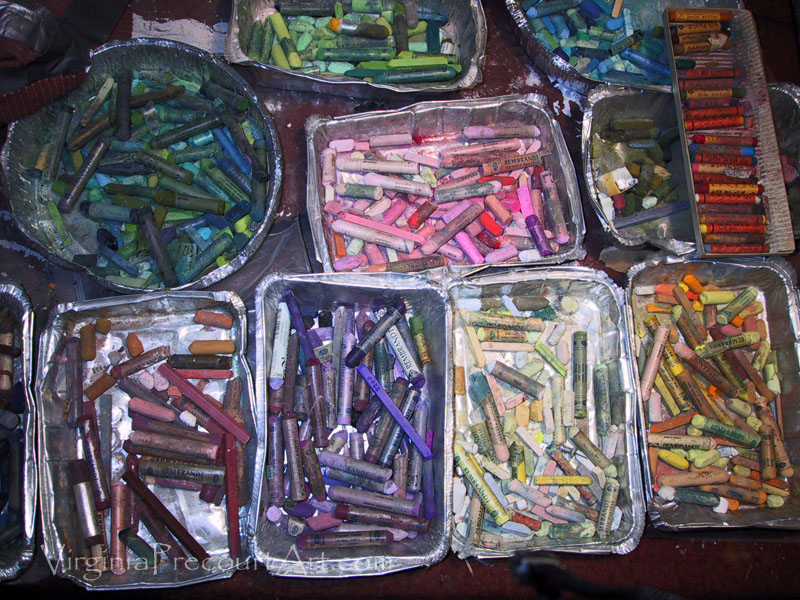
“I had hoped to find there some examples of tiles or
pottery with the kind of blue that I was looking for. And I understood it was in
this part of the country.”
Her research paid off: Though the blue mosque towers
were “exquisite,” their color was not just right. Behind an inn—a place that she
would describe as “my favorite spot in the entire world”—she found her elusive
blue.
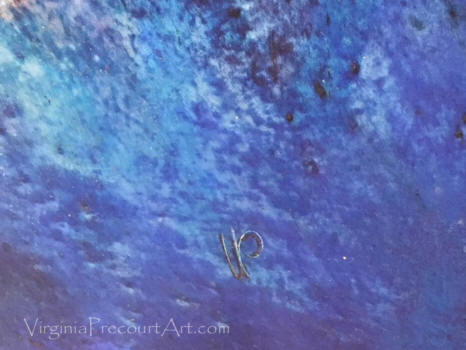
Detail: Genesis (1967)
And, with it, a recommitment to her art: “I went there
every day all by myself. I guess the colors and the energy that seemed to be
everywhere made me feel that anything these people believed was possible.
Reality and imagination were one and the same in this land.”
So, Virginia traveled for decades—to Afghanistan,
Bhutan, Bulgaria, China, England, Egypt, France, India, Iran, Italy, Nepal,
Rumania, and Spain — often in the company of a committee of artists and scholars
from Museum of Fine Arts in Boston who shared her goal of creating art that
endures.
.jpg)
Back home in her ground-floor studio in
Dover, Massachusetts—Virginia Strom Precourt brought that special blue hue into
the sky of an Afghani street scene. In tribute, she dropped a modest
self-portrait in among the huts, the dust, and the rocks.
If the inn outside Kabul was her most preferred retreat,
her studio was a close second. Set in a corner room with expansive light from
the North and the East, it overlooked a pond that sat on the far side of a dirt
road.
.jpg)
And just as much as Virginia Strom Precourt liked rocks
of the Middle East, she enjoyed the stones, sticks, and the fiddlehead ferns
that were part of the setting just outside her windows. And, just as exotic
semi-precious gems were part of her polyfrescos, so did the natural elements of
Dover find their way into her art.
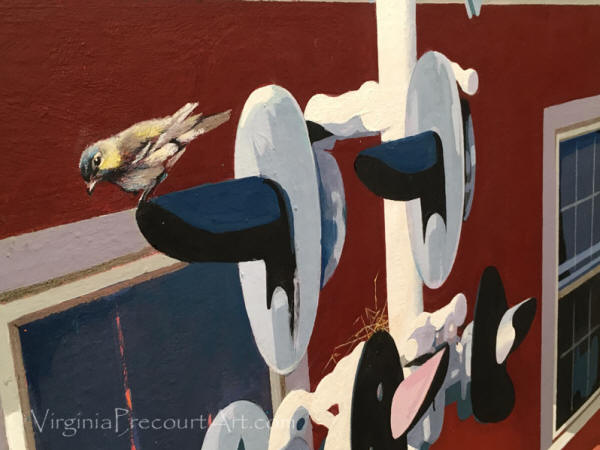
Detail: Whistlestop
The works that came out of that pondside studio traveled
as well: Virginia’s work has been featured in exhibitions at Arvest Galleries in
Boston; Boston’s Symphony Hall, the Copley Society in Boston; Vose Galleries on
Newbury Street in Boston; and the Weyerhaeuser Gallery in the Duxbury
(Massachusetts) Art Complex Museum.
When she died in 2008, Virginia Precourt’s works were
featured in museums as well private and corporate collections all over the
world. Closer to home, a massive mural is the centerpiece of a children’s museum
in Westwood, Massachusetts, the town that abuts Dover.
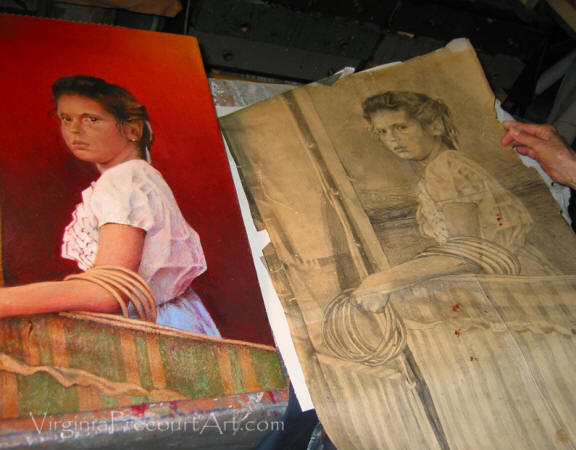
Neenah's Child: Maine Carnival (2003)
Virginia’s finished works, however, all begin with finely drawn sketches. Sketch after sketch of children. Sketches of birds. Of hands. Of lilies and of ponds. Of young ballerinas concentrating in their dance studies at Boston’s Cyclorama art center.
.jpg)
The drawings didn’t always have a deliberate purpose.
What she needed to bring those disparate drawings
together was light. And light—every bit as much as rocks—infused Virginia Strom
Precourt’s art. Just as polyvinyl acetates were the bonding agents that held
together her polyfrescos, so was light the element that sealed her art.
When she traveled the midcoast Maine shore or the hills
of Franklin County with her family, she would regularly command, “Stop the car!”
and insist that her friends and family “examine the light”, as her fingers
cropped a dappled roadside forest scene.
On such occasions, Virginia didn’t need a notebook or a
sketchpad. She would lock the image in her mind. And—whether it was a day, a
week, or a month later—when she returned to her studio, she gleefully would
reconstruct the moment.
And when those moments happened, she had a wall of
sketches to pick from and add substance to the light. Light is universal. Light
is permanent. Light is the soul of Virginia Strom Precourt’s artistic DNA.
The irony is that her roots track back to a part of the
country where sunlight is a precious seasonal commodity. Virginia Strom was born
in Duluth, Minnesota, in 1916 and moved to suburban Cleveland at the age of 11.
Her interest in art was nurtured at Laurel School in Shaker Heights, and
her draftsmanship was further developed when she came to Boston after graduation from
Laurel and enrolled at the Museum School in 1934.
Though Greater Boston would become her home 12 years
later, the initial fit wasn’t comfortable: Restless with the School’s
concentration of fundamentals, Virginia transferred to the Art Institute of
Chicago.
At which point,
the economy interrupted: “Two years later, I couldn’t sell a thing,"
she wrote in 2004. “My
parents declared, ‘Enough is enough’ and I had a choice: Either I come home or
try earning my own living for a change.
“I loved my
independent artist's life, but during those awful depression years I knew I
couldn't support myself painting pictures. But I could draw! I sought out
freelance commercial art assignments, mostly newspaper ads for children’s
apparel, sale items, and home furnishings. That experience taught me the
importance of disciplined productivity.
“The first of many
doors had opened to worlds of creative possibilities.”
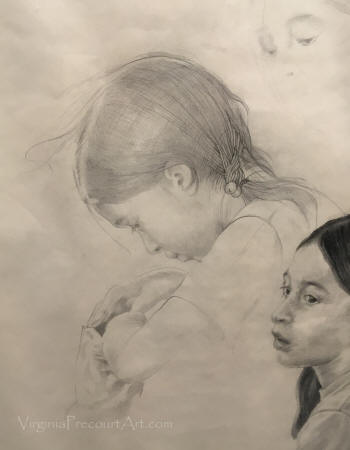
Detail: Study for "Garden Parties" Mural #3
Another door would open when she met the man who would
be a champion of her work and her husband for the balance of their life
together. Time Inc. recruited Harry Precourt from a Cleveland advertising agency
and transferred the young family—her first son was born in 1942—to the Greater
Boston area.
According to
Who Was Who in American Art—400 Years
of Artists in America, Mrs. Precourt then pursued her passion in art and
art history at the Cleveland School of Art; the Stuart School in Boston;
Radcliffe College; and the Child Walker Art School in Florence, Italy.
Her education continued when
she joined a committee of scholars and
artists
on an MFA committee that met regularly to research the conditions that contributed
to the permanency of art.
Virginia responded to the MFA
challenge with her creation of two new mediums.
She
continued to work on the polyfrescos whose inspiration she had found in the
Middle East and Indian Subcontinent. But even as she refined the process, the
pieces were unwieldy—finished pieces often weighed more than 200 pounds—and
often took years from initial casting to finished work.
To find a new window of expression, she developed a
technique that she called “pastel-leafs” that used a gold-leaf bonding agent that
would bring permanency to pastel works that otherwise were far more delicate.
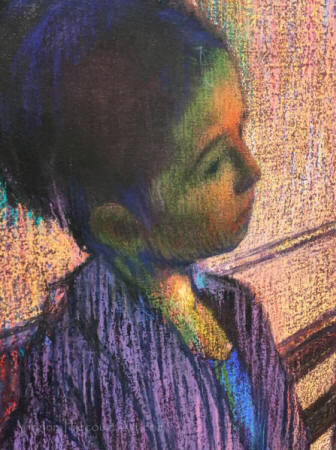
The
new technique gave new life to all those sketches and drawings

As she walked through her work space, she explained,
“Look at the beauty of that woman and that lovely color she’s wearing. And the
light around the children playing on the steps over there on the right like
children everywhere in the world.
“This young lady has the same look that interests and
fascinates me all the time,” she explains, pointing to the sketch of an Afghani
woman. “It’s universal. It’s forever.”
And from Bhutan to Boston, “I used the same pose with a
ballerina from that series of pastel-leafs.”
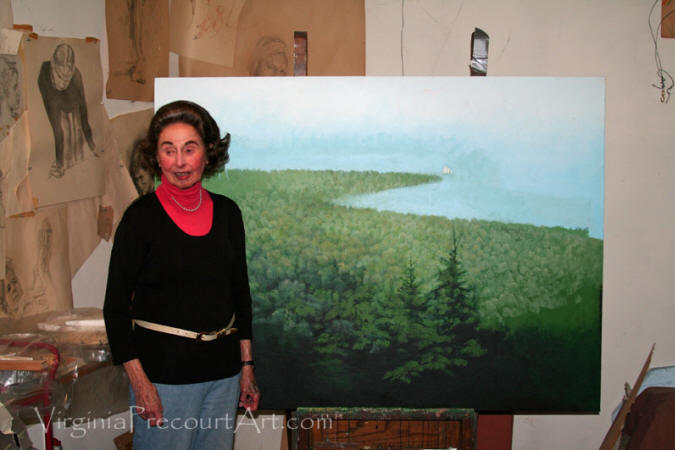
Virginia Strom Precourt’s own story is a tale of light shining from all corners of the world. It infuses everything she draws. And because she was a student of art as well as an artist, it will survive, even as it glows in the gallery space of WINTER LIGHT at Jan & John Maggs Antiques and Art.
—Geoffrey Precourt
~~~~~~~~~~~~~~~~~~~~~~~~~~~~~~~~~~~~~~~~~~~~